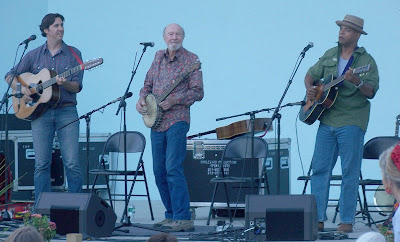- Alligators like to eat marshmallows.
- Bay Leaves come from the Bay Laurel tree, which grows wild in the bayous of Louisiana.
- If you ask nicely, the airboat driver will maneuver so you can cut off a few bunches of bay leaves to take home.
My second trip to the Big Easy was when I was in seminary. I was attending a seminar at New Orleans Baptist Theological Seminary and was only going to be in the city for a weekend. On Saturday night, the seminary dining hall pulled out all the stops and had “Cajun Night.” I wasn’t interested in dining hall food, even if was allegedly Cajun, so I hopped a bus and went into the French Quarter, where I wandered around until I found a bar that had zydeco music and the scent of jambalaya wafting onto the sidewalk. After a fantastic meal, I ended up at Café Du Monde for café au lait and beignets, then found myself strolling through the Jackson Square in front of St. Louis Cathedral, where I listened to some street musicians before taking the bus back to the seminary.

Having gotten to know the pastors and congregations of St. Matthew’s United Church of Christ and Central Congregational UCC, who have been worshipping together since Katrina, I feel as though I have family in New Orleans, so I am particularly anxious as I hear all of the reports of Hurricane Gustav bearing down on the city. Like everyone else, I worry about the levees holding and about the pumps working. I think about New Orleans being deserted, once again, as Mayor Nagin has ordered a mandatory evacuation of the city. I think about the people who are displaced as they take prudent action to get out of the path of category-three storm.
There seems so little we can do. In church, this morning, we prayed for the people along the Gulf coast as they prepared for the storm. I received an email yesterday from Rev. Jerry Foltz, the Central Atlantic Conference’s staff disaster response coordinator, inviting churches and individuals to give to the American Red Cross to help displaced people with groceries, travel assistance, cash assistance for gas or other evacuation expenses and replacement of medications and/or medical devices. We can pray and we can prepare and, if the worst happens, we can respond. “But,” I wondered, “is there something else we can do?”
Today, I was reminded of the “Hurricane Parties” that are so famous along the Louisiana coast. I thought of people getting together to ride out past storms with friends and families, with food, conversation and music. I’d like to believe that, perhaps in some magical way, those parties and their “laugh in the face of danger” attitude even helped to keep people and property safe. Today, though, there’s nobody in the Big Easy to have a party, so I’ve fried up a batch of beignets, brewed a pot of chicory coffee and put on a BeauSoleil CD.
Be safe, my friends.


.jpg)

